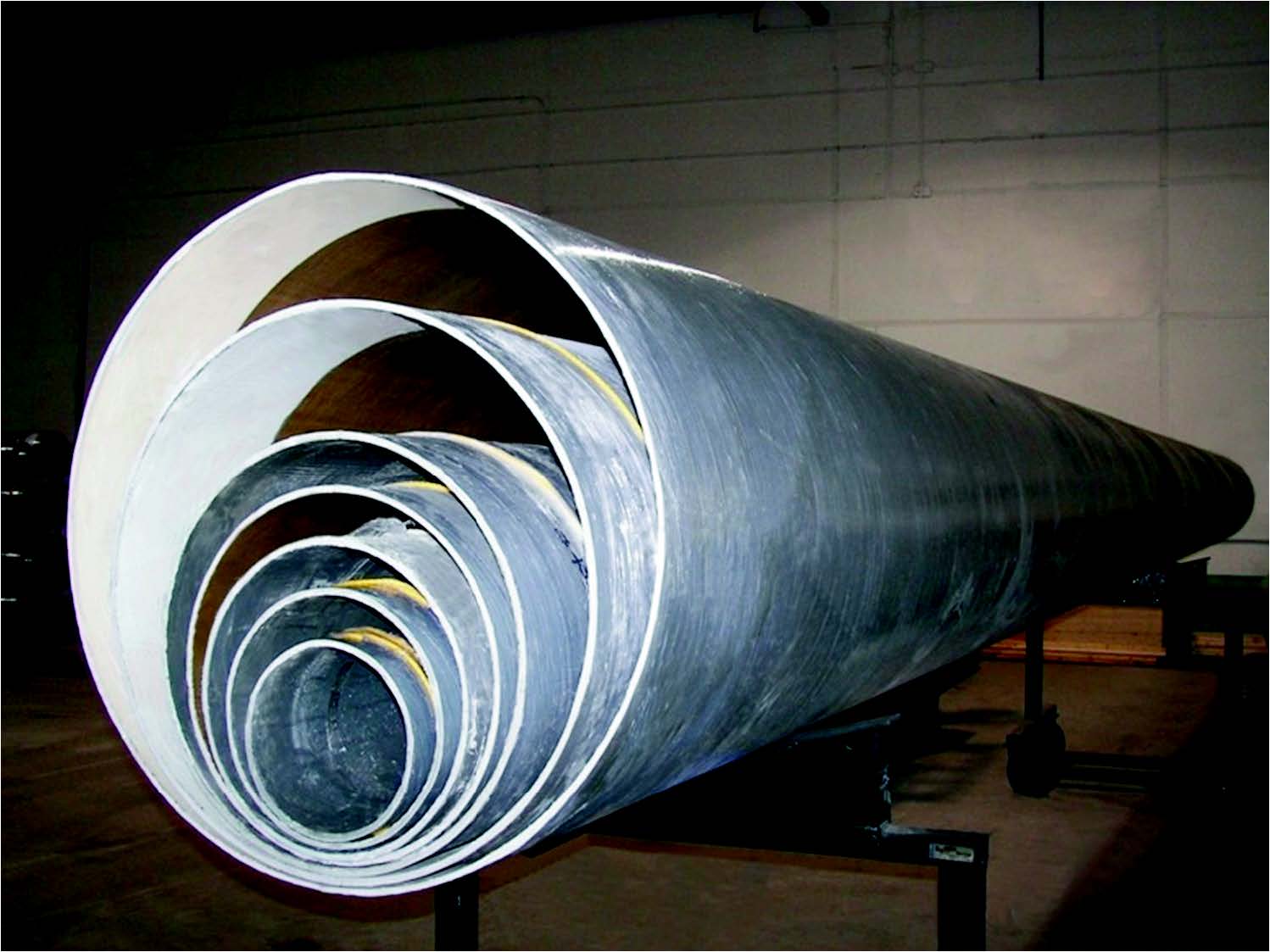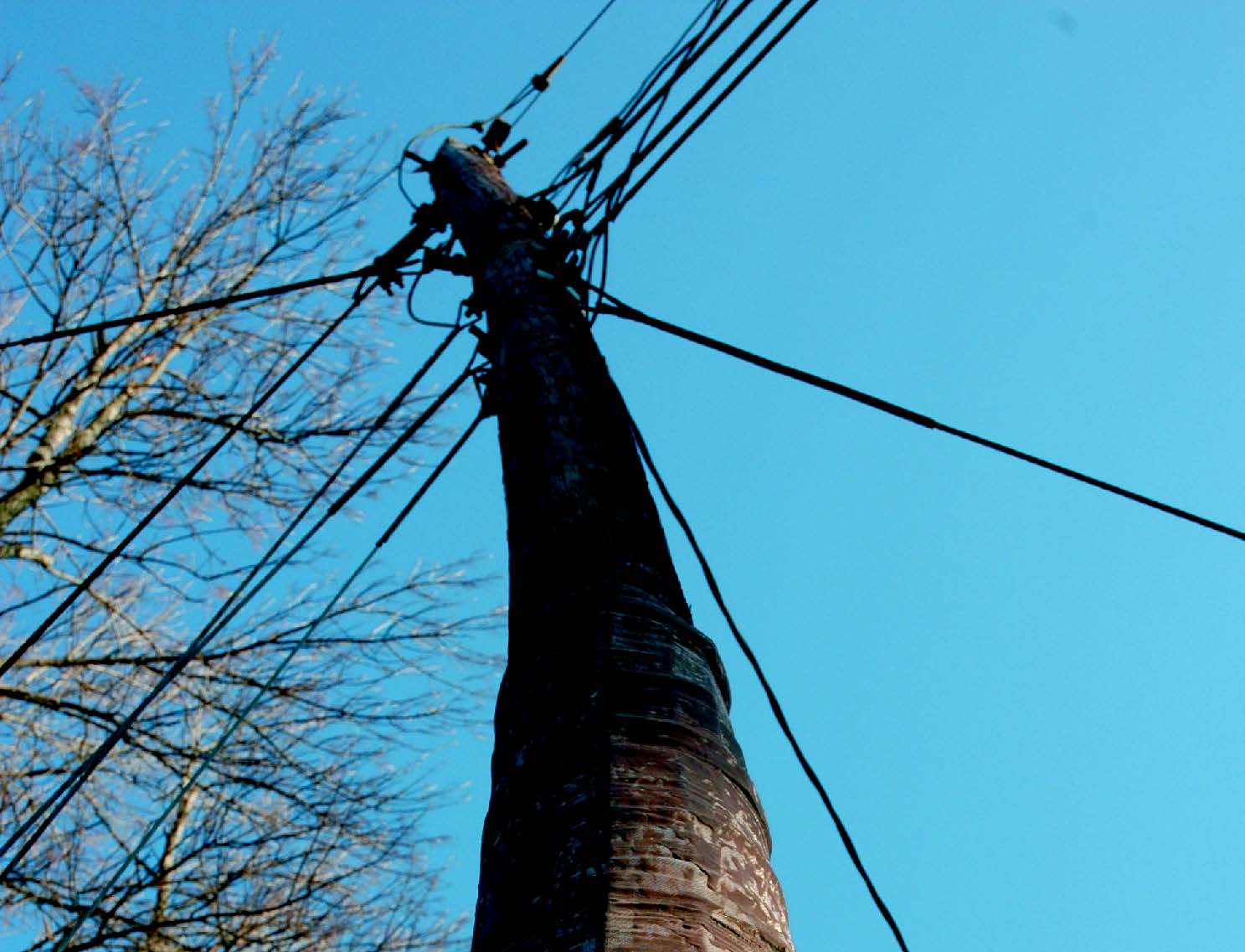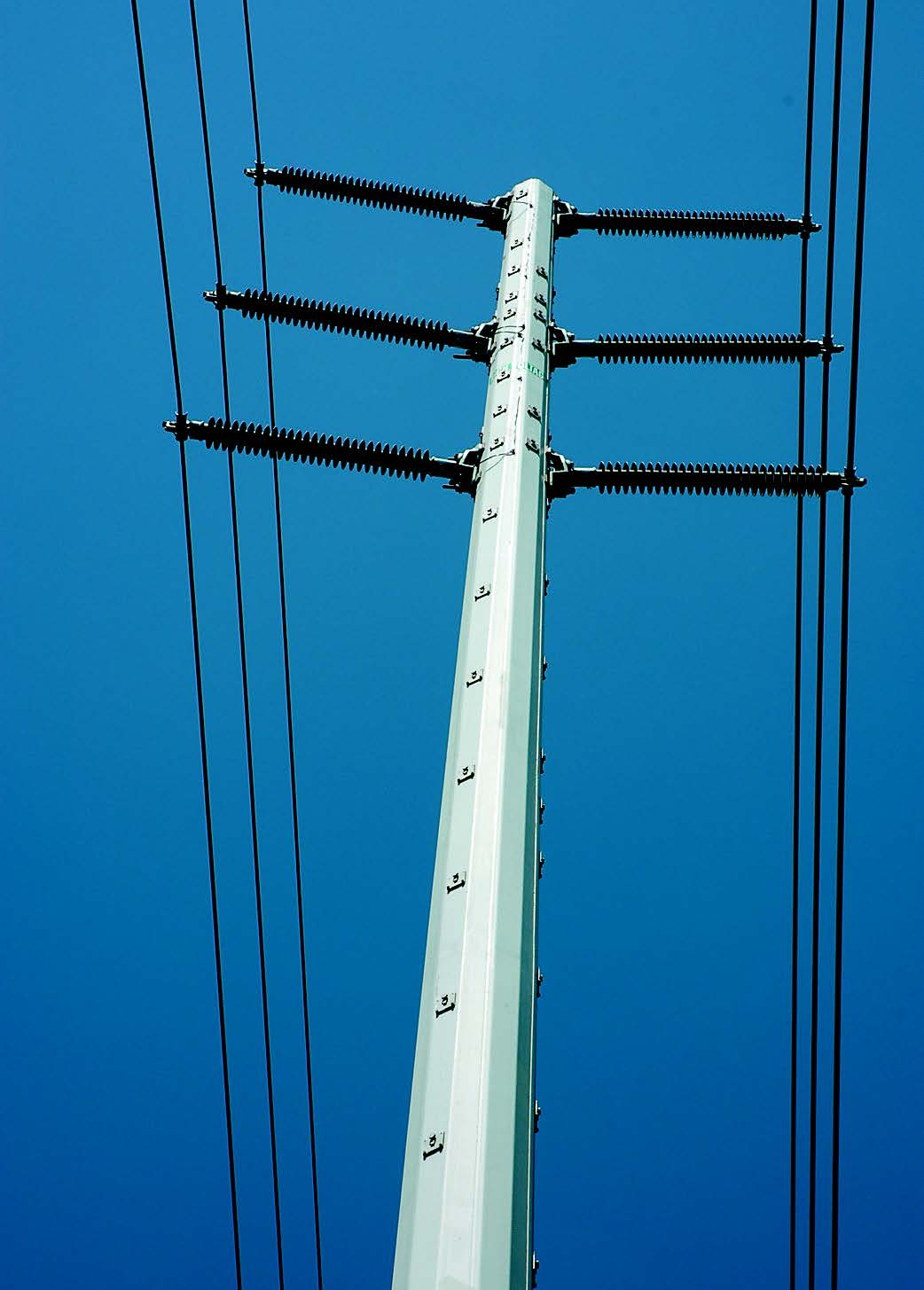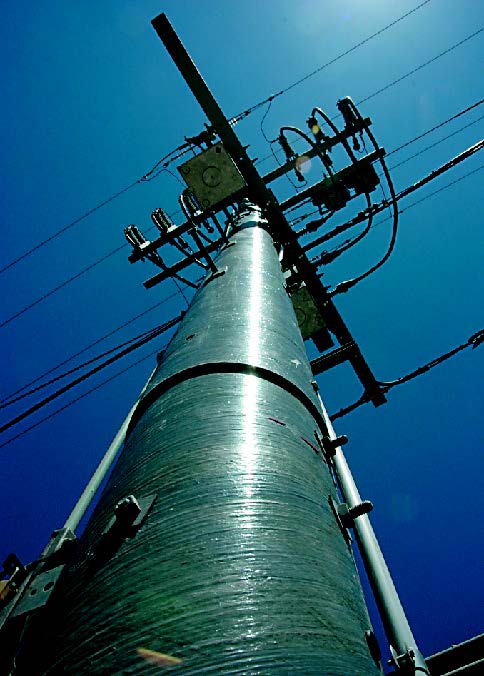
By Kevin C. Coates
Utilities have been working with several composite pole manufacturers and deploying various types of composite poles to service locations as pilot projects to evaluate composite pole performance. Recent winter storms have shown that composite utility poles have some important advantages over wood, concrete and steel structures.
The storms that blasted across Canada and the northern tier of the United States this past winter often left behind a beautiful blanket of snow and ice. Only with some of these storms, the peace and tranquility that normally accompanies the end of a gentle snow fall was instead punctuated by loud periodic “cracks” and “booms;” the sounds of wood poles snapping like toothpicks, felled by trees that collapsed under the weight of massive amounts of ice and snow.

In several instances, composite utility poles were installed as pilot projects in amongst the old wood pole infrastructure. To the amazement and pleasure of the host utilities, none of the composite utility poles came down or were significantly damaged. The various composite pole manufacturers could not have asked for a better test to prove the durability of their innovative poles.
What is now becoming increasingly obvious to the electric power industry is that some composite utility poles have finally matured into the “ready for deployment stage” where they can now be accepted as part of a utility’s replacement pole inventory. And, small wonder considering the potential cost savings that composite poles represent for utility pole installation, maintenance, repair, replacement, life cycles, and disposal.
The effects of weathering, termites, woodpeckers, rusting, high winds, and fires take a toll on pole infrastructure every year, which of course drives up maintenance costs, and reduces overall system reliability. The new generation of composite poles effectively mitigate these negative effects.
Significant advancements have been made in the design and manufacture of transmission and distribution poles using new high-strength E-Glass fibres and polyurethane resins. Utilities are beginning to recognize that composite poles manufactured with these new materials hold promise for dramatically reducing pole life cycle maintenance and the need for frequent pole replacements, even for reasons other than age. These improvements also hold promise to reduce the initial cost of setting a pole as well as reducing the need for pole replacements.
Background
The first poles used to support telegraph lines in the 19th century were from old growth or ancient forests and typically came from very dense and resilient hard woods. Over the years, old growth forests were decimated and ceased to be the primary source for transmission and distribution poles. Today’s rapid growth tree farms now produce, over decades, a pole with somewhat degraded properties; mainly, reduced durability, stiffness, and longevity. This means new wood poles are less robust and do not resist insect infestation or wood rot as well as the older generation poles. Service life is logically shorter.

To enhance pole longevity, today’s wood poles are treated with pentachlorophenol (a known carcinogen) suspended in a light oil (creosote) to enhance pole treatment. This eventually presents a handling and disposal challenge for utilities at the end of a pole’s service life. Environmental regulations now consider treated wood poles as hazardous waste; a significantly more expensive proposition than normal landfill disposal.
Wood poles have another vulnerability that is especially problematic in forested areas – they burn. This is where composite poles have a distinct advantage – they resist fire and will not support combustion without the addition of an external heat source.
Composite Characteristics
While not fireproof, composite poles are extremely fire resistant; especially, when coated with fire retardant. A propane flame can cause a composite pole to smolder with a limited amount of flame when applied directly to the surface of the pole, but as soon as the flame is removed, the composite material ceases to smolder or produce flame. This makes composite poles ideal for deployment in forested areas. More importantly, after exposure to fast moving brush fires, the poles will not likely require replacement and will continue to support the lines and equipment with no loss of strength.
The resilience of composites is one of their more desirable features. Composites allow strength parameters to be accurately “dialed-in” during manufacturing to meet the job specification. This saves time and money and eliminates waste. The service life of a composite pole is conservatively rated at 70 years on average. In addition, composite poles are extremely light weight, strong, and do not lose their strength over their lifetime.
Industry Acceptance
Obviously, any new product or technology offered to the electric power industry needs to be thoroughly tested before it can be deployed to a live grid. To better evaluate new electric power technologies that might enhance grid reliability and/or lower service costs, Southern California Edison (SCE) created a new section on their grid in San Bernardino known as the “Circuit of the Future.”

Southern California Edison worked closely with a number of composite pole manufacturers to help them design and manufacture a series of composite poles that meet SCE’s needs in terms of strength, durability, serviceability, and service life.
Each composite pole company has its own patented method of production, which means each type of pole has a unique set of characteristics.

The chemical composition of the resins, types and amounts of E-Glass, winding patterns and tensions vary significantly from one manufacture to another and account for various performance characteristic. These various manufacturing processes are naturally tightly held secrets.
Hardware Design
Attaching equipment to hollow composite poles, rather than solid wood poles, requires different hardware and methods. In most cases, hardware installation is very straightforward. For instance, rather than drilling holes and then bolting brackets directly into wood, a composite pole requires that a hole be drilled completely through both sides of the pole with the equipment brackets being attached by long through bolts, nuts, and plate washers (flat washers for pultruded poles and curved washers for round filament wound poles) on both sides to evenly disperse the clamping force.
One of the tasks composites have made less strenuous on linemen, if not easier, is cross arm replacement. Wood cross arms are routinely replaced as a result of wood deterioration or mechanical damage. Traditional wood cross arms are heavy and can be unwieldy when being handled by a lineman working at the top of a pole. Unfortunately this work often results in back strains and days of lost work for linemen. The potential for injuries and time lost from work is substantially reduced when composite cross arms are substituted for wood arms because the composite weight is significantly less, thus making the composite arm easier to handle at the top of pole.
More Installation Options
Hollow composite poles allow more flexibility during pole erection. This is especially true when erecting poles along constricted rights of way that require poles to be set by hand or with heavy cranes. Because composite poles are available in two forms; one form being single length poles and the second being modular poles that are stacked together to the desired height. The second form makes it possible for the pole to be erected by a line crew using hand tools and equipment because the line crew is working with a series of shorter and lighter modules rather than a single heavier length pole.
Modular poles are inherently much more versatile than either the single length wood or composite poles and are shipped nested one inside the other so that when unloaded, taken apart and assembled, will yield a pole of specific length and class. This flexibility makes for faster response times in emergency disaster relief efforts because assembly can be performed by a utility at their own facility or in the field. An emergency situation might require a pole of a specific length and class in order to be able to return service to an area.
However, there may not be any poles available in inventory to meet the length and class requirements for the job. Rather than delay the job or erect a costly temporary work-around that will, at some point, require removal, it would be more efficient and cost effective to separate some of the existing pole bundles and pick out the specific modules needed to assemble a pole that meets the job requirements. Resin Systems builds several different length and strength pole modules which can be assembled in several combinations to create a pole of a desired length and class and is the only company to date offering this design option.
In mountainous areas, distribution poles are frequently damaged during heavy annual snowstorms. A common problem from these storms is that the snow laden trees will fall across distribution lines which can and often does result in a pole breaking off 5 to 8 feet above the ground line. Many of these pole breaks are in remote locations which means that most of the repair/replacement work will have to be performed by hand. To make matters worse, these poles are often set in very rocky soil that makes it very difficult and time consuming to exhume the buried pole section.
According to Mikel Rodin, formerly a senior engineer with SCE, the timely and cost-effective method to effect a repair in rocky terrain is by trimming the damaged pole down to a point where there are about 2 metres of undamaged solid stub remaining. By using an equivalent length and class of composite sectional pole trimmed to remove the bottom portion of the module equal to the length of the embedded portion of the wood pole, a composite module can be set down over the wood stub and secured with through bolts after cross drilling through both pole modules approximately 1 metre above grade. Then, a closed cell foam is injected to fill any existing void between the stub and the bottom composite pole module. The remaining composite modules are used to finish erecting the new pole combination.
Over the past 10 years, there have been a number of in-depth studies performed by both E-Glass/resin manufactures and independent laboratories. All have concluded there are no negative health issues that will result from working with composite poles (i.e., activities such as handling, cutting, drilling, and sanding, etc.).
Major Benefits
To appreciate the real value of composite poles, which typically can range from one and a half to twice the price of a comparable wood pole, utilities need to look past the initial capital and focus on the comparison between the actual life cycle costs associated with each type of pole. Such comparisons will identify areas where a utility could realize significant savings for the maintenance side of the business.
Over the life of a composite pole (rated conservatively at a minimum of 70 years), at least two wooden poles would need to be purchased, which is an obvious value proposition just on the purchase price alone, since the cost of only one installation would be required instead of two. Because composite poles are not affected by such things as insect infestations, woodpeckers, fungi, outer shell cracking, or loss of heartwood as a result of decay, they do not require periodic intrusive inspections or internal chemical treatments which can be very costly over the life of the wood pole.
Kevin C. Coates is a Washington-based energy, electric utility and transportation consultant and technology writer.